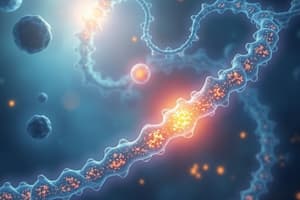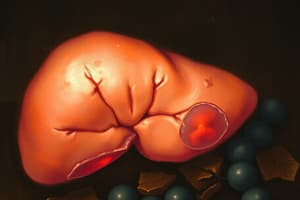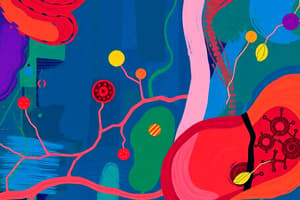Podcast
Questions and Answers
Which tissues are known to require a continuous supply of glucose as a metabolic fuel?
Which tissues are known to require a continuous supply of glucose as a metabolic fuel?
- Red blood cells, testes, exercising muscle (correct)
- Brain, liver, muscle
- Adipose tissue, kidneys, cornea
- Liver, lens, pancreas
What is the primary gluconeogenic precursor derived from the breakdown of triacylglycerols?
What is the primary gluconeogenic precursor derived from the breakdown of triacylglycerols?
- α-ketoacids
- Pyruvate
- Lactate
- Glycerol (correct)
Which enzyme is responsible for phosphorylating glycerol to form glycerol phosphate?
Which enzyme is responsible for phosphorylating glycerol to form glycerol phosphate?
- Glucose-6-phosphate isomerase
- Dihydroxyacetone kinase
- Glycerol phosphate dehydrogenase
- Glycerol kinase (correct)
During a prolonged fast, what percentage of gluconeogenesis is provided by the kidneys?
During a prolonged fast, what percentage of gluconeogenesis is provided by the kidneys?
Which molecules are known to be gluconeogenic precursors?
Which molecules are known to be gluconeogenic precursors?
In a normal overnight fast, what percentage of gluconeogenesis occurs in the liver?
In a normal overnight fast, what percentage of gluconeogenesis occurs in the liver?
Why does gluconeogenesis not simply involve the reversal of glycolysis?
Why does gluconeogenesis not simply involve the reversal of glycolysis?
What is the first step in converting glycerol to glucose via gluconeogenesis?
What is the first step in converting glycerol to glucose via gluconeogenesis?
What is the first step in gluconeogenesis when starting from pyruvate?
What is the first step in gluconeogenesis when starting from pyruvate?
What is the role of biotin in gluconeogenesis?
What is the role of biotin in gluconeogenesis?
Which of the following compounds cannot contribute to the net synthesis of glucose?
Which of the following compounds cannot contribute to the net synthesis of glucose?
Which molecule is primarily converted back to glucose in the liver during gluconeogenesis?
Which molecule is primarily converted back to glucose in the liver during gluconeogenesis?
Which amino acids are primarily responsible for supplying glucose during fasting?
Which amino acids are primarily responsible for supplying glucose during fasting?
Which of these statements best describes the reactions unique to gluconeogenesis?
Which of these statements best describes the reactions unique to gluconeogenesis?
What does the conversion of α-ketoglutarate in gluconeogenesis primarily yield?
What does the conversion of α-ketoglutarate in gluconeogenesis primarily yield?
In which cellular location does the carboxylation of pyruvate to oxaloacetate occur?
In which cellular location does the carboxylation of pyruvate to oxaloacetate occur?
Flashcards
Gluconeogenesis
Gluconeogenesis
The metabolic pathway that produces glucose from non-carbohydrate sources, like lactate, pyruvate, glycerol, and amino acids.
Gluconeogenic precursors
Gluconeogenic precursors
Molecules used to produce glucose via gluconeogenesis. Examples include glycerol, lactate, and certain amino acid derivatives
Glycerol
Glycerol
A product of the breakdown of fats that can be used as a source of carbon to make glucose through gluconeogenesis in the liver
Glycogen stores
Glycogen stores
Signup and view all the flashcards
Liver's role in gluconeogenesis
Liver's role in gluconeogenesis
Signup and view all the flashcards
Lactate
Lactate
Signup and view all the flashcards
Glycolysis
Glycolysis
Signup and view all the flashcards
Gluconeogenesis
Gluconeogenesis
Signup and view all the flashcards
Lactate in Gluconeogenesis
Lactate in Gluconeogenesis
Signup and view all the flashcards
Amino acids & Gluconeogenesis
Amino acids & Gluconeogenesis
Signup and view all the flashcards
Pyruvate Carboxylase
Pyruvate Carboxylase
Signup and view all the flashcards
Oxaloacetate (OAA)
Oxaloacetate (OAA)
Signup and view all the flashcards
PEP Carboxykinase
PEP Carboxykinase
Signup and view all the flashcards
Biotin's role in Gluconeogenesis
Biotin's role in Gluconeogenesis
Signup and view all the flashcards
Irreversible Glycolysis Reactions
Irreversible Glycolysis Reactions
Signup and view all the flashcards
Acetyl CoA & Gluconeogenesis
Acetyl CoA & Gluconeogenesis
Signup and view all the flashcards
Liver & Gluconeogenesis Role
Liver & Gluconeogenesis Role
Signup and view all the flashcards
Study Notes
Gluconeogenesis Overview
- Some tissues (brain, red blood cells, etc.) need a continuous glucose supply.
- Liver glycogen is a short-term source (10-18 hours).
- During extended periods without food, glucose is made from precursors like lactate, pyruvate, glycerol, and α-ketoacids.
- Gluconeogenesis is a specialized pathway, not a reversal of glycolysis.
- The liver primarily produces glucose (90%) during overnight fasts, with kidneys contributing 10% initially.
- During extended fasting, the kidneys become a major glucose source, contributing about 40% of total production.
Gluconeogenesis Substrates
- Gluconeogenic precursors are molecules used to synthesize glucose.
- These include glycolysis intermediates, TCA cycle intermediates, and α-keto acids.
- Glycerol, released from triacylglycerol breakdown in adipose tissue, is a crucial precursor.
- Glycerol is phosphorylated by glycerol kinase in the liver, forming glycerol phosphate.
- Glycerol phosphate is then oxidized to Dihydroxyacetone phosphate via glycerol phosphate dehydrogenase.
- Adipose lacks glycerol kinase, preventing the process there.
Studying That Suits You
Use AI to generate personalized quizzes and flashcards to suit your learning preferences.




